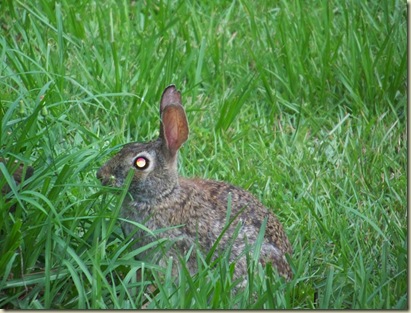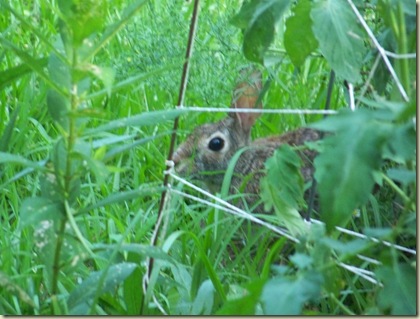Almost every evening now, we are seeing the "wascally wabbit." One evening we were coming back from our walk, and there he was almost at our feet, frozen, still as a stone. The next night we were watching for him and sure enough, he was in the same spot. I kept walking and grabbed my camera.
He did not stay still but played peek-a-boo with me through the tomato plants.
He hopped across the driveway.
And then he had had enough of that game and ---he was gone!
While we have been observing him lately, the question has been raised, "Do rabbits blink?" Ours does not appear to. B says when a hawk is coming, he needs to see it. So today, I Googled the question and sure enough, others have wondered the same thing -- or the same think? The answer is yes, but not very often. The Wisconsin House Rabbit Society has the following information on their web page:
....the function of the "third eyelid." Many animals, from amphibians to birds to mammals, possess this structure, known as a nictitating membrane. The primary role of the third eyelid is to protect the eye against injury. And people with albino rabbits, whose light eyes make the membrane very visible, will tell you that the membrane comes down over the eye when the bunny is frightened. In the rabbit, the third eyelid also helps keep the eye moist, which may explain why rabbits only blink 10 to 12 times an hour.
http://www.wisconsinhrs.org/Articles/What%20Do%20Rabbits%20See.htm
Soooo, we blink on an average of 720 times per hour.
(http://www.almanac.com/question/oneanswer.php?questionnumber=12915)
or 960 times per hour, depending on who you ask.
http://answers.yahoo.com/question/index?qid=20070824160240AAhRoME
(No wonder we are tired at the end of the day: we are just blinkin' worn out!)
From other web pages, I read that rabbits blink so quickly (though not often), we may not detect it.
I had heard that alligators have this third eyelid, too that they close when swimming under water. It is "see through" and still protects the eyes.
Is this why you almost always get that white-eye look in rabbit photographs?
We will be looking at him with different eyes, now.




No comments:
Post a Comment